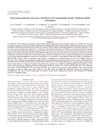Please use this identifier to cite or link to this item:
https://accedacris.ulpgc.es/handle/10553/75521
| Title: | Swimming behavior and prey retention of the polychaete larvae Polydora ciliata (Johnston) | Authors: | Hansen, B. W. Jakobsen, H. H. Andersen, A. Almeda García, Rodrigo Pedersen, T. M. Christensen, A. M. Nilsson, B. |
UNESCO Clasification: | 251001 Oceanografía biológica | Keywords: | Polydora ciliata Low Reynolds number hydrodynamics Swimming behavior Prey selection |
Issue Date: | 2010 | Project: | MICROROL - Role of microzooplankton in marine food webs dynamics: functional diversity, relevance in C, N and P cycles and trophic impact on primary producers (CTM2004-02575/MAR) | Journal: | Journal of Experimental Biology | Abstract: | The behavior of the ubiquitous estuarine planktotrophic spionid polychaete larvae Polydora ciliata was studied. We describe ontogenetic changes in morphology, swimming speed and feeding rates and have developed a simple swimming model using low Reynolds number hydrodynamics. In the model we assumed that the ciliary swimming apparatus is primarily composed of the prototroch and secondarily by the telotroch. The model predicted swimming speeds and feeding rates that corresponded well with the measured speeds and rates. Applying empirical data to the model, we were able to explain the profound decrease in specific feeding rates and the observed increase in the difference between upward and downward swimming speeds with larval size. We estimated a critical larval length above which the buoyancy-corrected weight of the larva exceeds the propulsion force generated by the ciliary swimming apparatus and thus forces the larva to the bottom. This modeled critical larval length corresponded to approximately 1 mm, at which, according to the literature, competence for metamorphosis and no more length increase is observed. These findings may have general implications for all planktivorous polychaete larvae that feed without trailing threads. We observed bell shaped particle retention spectra with a minimum prey size of approximately 4 μm equivalent spherical diameter, and we found that an ontogenetic increase in maximum prey size add to a reduction in intra-specific food competition in the various larval stages. In a grazing experiment using natural seawater, ciliates were cleared approximately 50% more efficiently than similar sized dinoflagellates. The prey sizes retainable for P. ciliata larvae covers the microplankton fraction and includes non-motile as well as motile prey items, which is why the larvae are trophically positioned among the copepods and dinoflagellates. Not only do larval morphology and behavior govern larval feeding, prey behavior also influences the feeding efficiency of Polydora ciliata. | URI: | https://accedacris.ulpgc.es/handle/10553/75521 | ISSN: | 0022-0949 | DOI: | 10.1242/jeb.038810 | Source: | Journal of Experimental Biology [ISSN 0022-0949], v. 213, n. 18, p. 3237-3246 |
| Appears in Collections: | Artículos |
Items in accedaCRIS are protected by copyright, with all rights reserved, unless otherwise indicated.
